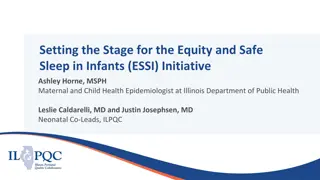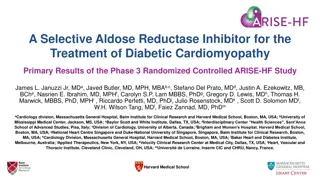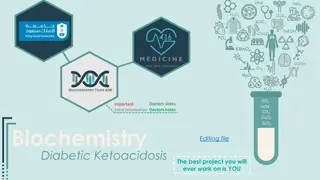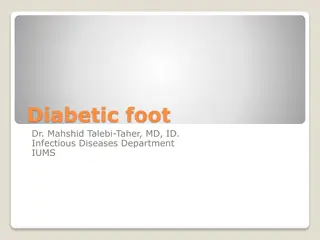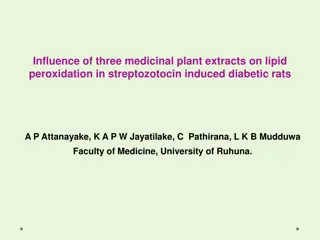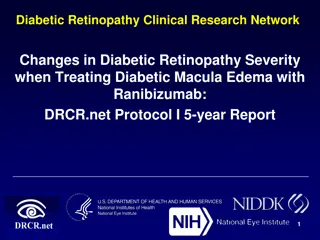
Impact of Maternal Diabetes on Newborns: Complications and Management
Understanding the impact of maternal diabetes on newborns is crucial. From defining GDM and IDM to discussing complications such as macrosomia and respiratory distress syndrome, this article covers it all. Learn about prevention strategies, management approaches, and the prognosis for infants of diabetic mothers.
Download Presentation

Please find below an Image/Link to download the presentation.
The content on the website is provided AS IS for your information and personal use only. It may not be sold, licensed, or shared on other websites without obtaining consent from the author. If you encounter any issues during the download, it is possible that the publisher has removed the file from their server.
You are allowed to download the files provided on this website for personal or commercial use, subject to the condition that they are used lawfully. All files are the property of their respective owners.
The content on the website is provided AS IS for your information and personal use only. It may not be sold, licensed, or shared on other websites without obtaining consent from the author.
E N D
Presentation Transcript
OBJECTIVES Define the GDM and IDM Review the incidence of maternal Diabetes mellitus Discuss briefly the effects of maternal diabetes on the fetus Discuss the management of an IDM How we can prevent the complications of IDM Discuss the prognosis for an IDM
INTRODUCTION Diabetes in the mother presents various problems for the newborn. These are determined by the severity and duration of the disease in the mother, the degree of control of her condition, and the gestational age of the infant. When diabetes of the mother is under good control from conception and throughout pregnancy, the adverse effects on the newborn infant are minimal. Maternal diabetes may cause fetal death in third trimester of pregnancy
PATHOPHYSIOLOGY Many newborn infants of diabetic mothers have serious complications. When the mother is hyperglycemic, large amounts of glucose are transferred to the fetus. This makes the fetus hyperglycemic. In response, the fetal pancreas (islet cells) produces large amounts of fetal insulin. Hyperinsulinism, along with excess production of protein and fatty acids, often results in a newborn infant who weighs more than 4082 g (9 lb). Such an infant is designated large for gestational age (LGA), and this condition is termed macrosomia (macro, large, and soma, body ).
This infant is prone to injuries at birth because of his or her size After delivery the infant often has low blood glucose levels because of the abrupt loss of maternal glucose and hypertrophy of the pancreatic islet cells, which results in a temporary overproduction of insulin. The infant has a characteristic cushingoid appearance because of increased subcutaneous fat. The face is round and appears puffy, and the infant appears lethargic.
The size of these newborn infants makes them appear healthy, but this is deceptive because they often have developmental deficits and may suffer complications of respiratory distress syndrome (RDS) or congenital anomalies. In contrast, some infants born to a mother with severe diabetes may be small for gestational age (SGA) because of poor placental perfusion.
Clinical Features Large for gestational age (macrosomia), Very plump and full faced Abundant vernix caseosa Plethora (polycythemia) Listless and lethargic Jitteriness
Hypoglycemia Symptoms Jitteriness Seizures Apnea/cyanosis Irritability Hypotonia Poor feeding Hypothermia
Potential neonatal complications 1. Growth/ Metabolic problems 2. Glucose Metabolism/ Hypoglycemia 3. Electrolyte imbalances 4. Respiratory Issues 5. Cardiovascular Issues 6. Hematologic Changes 7. Birth Trauma 8. Neurologic Issues 9. GI/GU Issues
1. Growth Poor maternal glycemic control predicts neonatal macrosomia > 95%-tile considered abnormal IDM generally have increased fat mass so will have higher weight than length and head circumference percentiles
These infants suffer from hypoglycemia, hypo calcemia, and hyper bilirubinemia. The nursing care of the infant of a diabetic mother includes close monitoring of vital signs, early feeding, and frequent assessment of blood glucose levels for the first 2 days of life. Hypoglycemia in the first days of life is defined as a blood glucose level that falls below 40 mg/dL. It can result in rapid and permanent brain damage. The infant should be closely watched for signs of irritability, tremors, and respiratory distress.
Therapeutic Management The most important management of IDMs is careful monitoring of serum glucose levels and observation for accompanying complications such as RDS. The infants are examined for the presence of any anomalies or birth injuries, and blood studies for determination of glucose, calcium, hematocrit, and bilirubin are obtained on a regular basis.
Because the hypertrophied pancreas is so sensitive to blood glucose concentrations, the administration of oral glucose may trigger a massive insulin release, resulting in rebound hypoglycemia. Therefore, feedings of breast milk or formula begin within the first hour after birth, provided that the infant's cardio respiratory condition is stable.
Approximately half of these infants do well and adjust without complications. Infants born to mothers with poorly controlled diabetes may require IV dextrose infusions. Treatment with 10% dextrose and water (IV) is initiated with the goal of maintaining serum blood glucose levels above 45 mg/dl
Oral and IV intake may be titrated to maintain adequate blood glucose levels. Frequent blood glucose determinations are needed for the first 2 to 4 days of life to assess the degree of hypoglycemia present at any given time. Testing blood taken from the heel with calibrated portable reflectance meters (e.g., glucometers) is a simple and effective screening evaluation that can then be confirmed by laboratory examination.
Nursing diagnosis Risk for unstable glucose level related to hypoglycemia secondary to intrauterine hyperinsulin state resulting from maternal gestational diabetes as evidenced by low blood glucose level, irritability, pallor, sweating, and apnea Impaired gas exchange related to respiratory distress secondary to delayed lung maturity resulting from inhibition of pulmonary surfactant production due to fetal hyperinsulinemia as evidenced by grunting, nasal flaring, retractions, tachypnea, and tachycardia
Nursing Care Management The nursing care of IDMs involves Early examination for congenital anomalies, signs of possible respiratory or cardiac problems, maintenance of adequate thermoregulation, Early introduction of carbohydrate feedings as appropriate, and monitoring of serum blood glucose levels.
IV glucose infusion requires careful monitoring of the site and the neonate's reaction to therapy; high glucose concentrations ( 12.5%) should be infused via a central line instead of a peripheral site.
Because macrosomic infants are at risk for problems associated with a difficult delivery, they are monitored for birth injuries, such as brachial plexus injury and palsy, fractured clavicle, and phrenic nerve palsy. Additional monitoring of the infant for problems associated with this condition (polycythemia, hypo calcemia, poor feeding, and hyper bilirubinemia) is also a vital nursing function.
Some evidence indicates that IDMs have an increased risk of acquiring type 2 diabetes and metabolic syndrome in childhood or early adulthood therefore, nursing care should also focus on healthy lifestyle and prevention later in life with IDMs.
Summary Maternal hyperglycemia in the first trimester time of conception, during fetal organogenesis result in major birth defects and spontaneous abortions Diabetic embryopathy can be prevented by control of diabetes BEFORE CONCEPTION
Bibliography Suraj Gupte, The short text book of pediatric, 11th edition, Jaypee Brothers Medical Publishers: New Delhi. Parul Datta, pediatric nursing, 4th edition, Jaypee Brothers; New Delhi. Marylyn Hocken Berry, David Wilson Chryl C Rodgers, Wong s Essentials of Pediatric Nursing, 10th Edition, Elsevier

